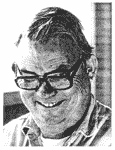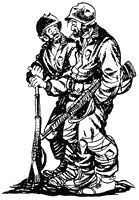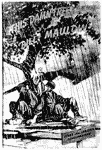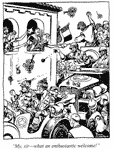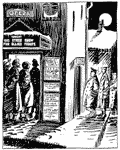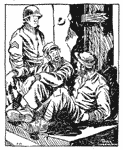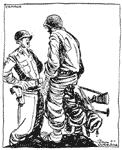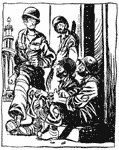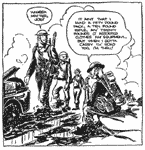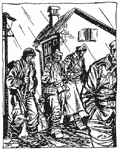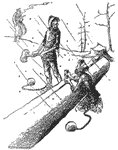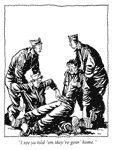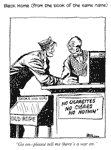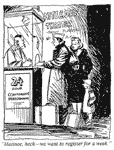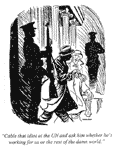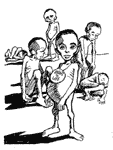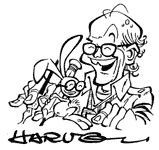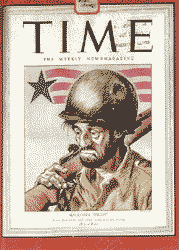 Bill
Mauldin Fades Away Bill
Mauldin Fades Away The Old Soldier Gets a Yahtzee Twice the subject of
a Time cover story--at least once more than any other cartoonist--Bill
Mauldin created some of the most memorable cartoon images of the 20th
century, and in the end, he was honored for it as no other cartoonist--and
few mere mortals--ever has been. Mauldin
was perfect for a career as a political cartoonist. He could draw anything,
and he was eager to take on the establishment. "If I see a stuffed shirt,"
he would say, "I want to punch it." From which his advice to political
cartoonists everywhere follows as logically as the day follows night:
"If it's big, hit it. You can't go far wrong." Mauldin
was famous as an anti-authoritarian critic by the time he was twenty-four
years old. He acquired his
notoriety in the most authoritarian of societies, the U.S. Army during
World War II: in the cartoons he drew for military newspapers, he depicted
the life of the "dogface" (foot soldier) the way it was.
Rained on and shot at and kept awake in trenches day and night,
the combat soldier was wet, scared, dirty, and tired all the time; and
Mauldin's spokesmen--the scruffy, bristle-chinned, listlessly dull-eyed,
stoop-shouldered Willie and Joe in their wrinkled and torn uniforms--were
taciturn but eloquent witnesses on behalf of the prosecuted. Through
simple combat-weary inertia, they defied pointless army regulations
and rituals: they would fight the war, but they wouldn't keep their
shoes polished. Once
we see them, in their usual state of slovenly disarray, stopped on the
street of a freshly captured Italian town. They are standing outside
a temporarily designated officers club while an officious-looking lieutenant
in neatly pressed uniform points accusingly at the front of Willie's
shirt. Willie responds, "Them buttons wuz shot off when I took this
town, sir." Perhaps
in the same town a day or so later, Willie and Joe are seated, wearing
garrison caps and comfortably slouching, on the stoop of a bombed-out
building. Looking at them with vague disapproval is a rear echelon corporal.
"He's right, Joe," says Willie, "When we ain't fightin' we should ack
like sojers." Because
they so faithfully represented the average foot soldier's plight and
proclivities, Mauldin's cartoons were immensely popular with the men
in the trenches. And that very popularity was an affront to generally
accepted notions of military propriety, but Mauldin never wavered even
after the Third Army's legendary General George S. Patton leaned on
him. Old
Blood-and-Guts Patton could have had an alternate moniker, Old Spit-and-Polish,
so dedicated was he to spic-and-span uniform maintenance as a symbol
of--and, indeed, as a significant contributor to--the highest military
discipline, the sort necessary for successful battlefield operations.
To Patton, Mauldin's Willie and Joe were seditious influences, and Mauldin
was a dangerous anarchist. "If
that little son of a bitch sets foot in Third Army, I'll throw his ass
in jail," Patton once fumed, loudly. But Patton's boss, Supreme Allied
Commander General Dwight Eisenhower, thought otherwise. It was the soldiers'
paper, he said; let them alone. But he also thought it would be a good
idea for Patton to meet Mauldin, and so the cartoonist had an encounter
with the martinet of the Third Army "Where
did you ever see soldiers like that?" Patton asked Mauldin. "You know
goddamn well you're not drawing an accurate representation of the American
soldier. You make them look like goddamn bums. No respect for the army,
their officers, or themselves. You know as well as I do that you can't
have an army without respect for officers. What are you trying to do--incite
a goddamn mutiny?" Mauldin,
however, was not much cowed by the tirade that Patton conducted When
Patton finally gave him the opportunity speak, Mauldin defended himself. "I
knew these guys best," Mauldin said in recalling the encounter afterwards,
"and [the cartoons] gave the typical soldier an outlet for his frustrations,
a chance to blow off steam." To
Patton, he elaborated in terms designed to appease the disciplinarian:
"The average soldier has a lot to gripe about," Mauldin said, "and if
he stews long enough about it, he's not going to be thinking about his
job. But he picks up his paper and reads a letter or sees a cartoon
by some other soldier who feels the same way, and he says, 'Hell, somebody
else said it for me,' and he goes back to his job."
Mauldin
knew, as few cartoonists do, exactly how his cartoons worked. But
his explanation didn't change Patton's mind: if the soldiers in the
field were "stewing" about their lot in life, the general opined, it's
because they didn't have enough to do. Patton
didn't change Mauldin's mind either. Willie and Joe remained bedraggled
in the extreme and unshaven in perpetuity. Even
in the hospital. Here's Willie, bearded, at full-length slouch in bed.
One of the army doctors in attendance says to the others, "I think he
should at least try to lie at attention." And
Mauldin persevered in depicting the numbing boredom and menacing danger
and foxhole mud of the soldier's life, poking fun at army brass and
exposing regulations as clueless whenever they meet reality as he bumped
along the frontlines in the jeep assigned to him by General Mark Clark,
commander of the forces in Italy, so that he wouldn't have to hitchhike
wherever he went. In
one of Mauldin's classics, we see two officers standing on a bluff looking
at a majestic mountain vista beyond which the sun is setting in glorious
color. One officer turns to the other and says, "Beautiful view! Is
there one for the enlisted men?" But
soldiers must live with their officers. A car with a three-star license
plate pulls up next to the officers' mess tent, and the mess cook standing
at the door of the tent says, "Another dang mouth to feed." Willie
and Joe found comfort where they could. During a cold downpour, they
take shelter under a tarp they've rigged between trees, and Joe has
opened the flap to see a shivering, starved-looking mutt whimpering
at them in the rain. "Let 'im in," Willie says, "I wanna see a critter
I kin feel sorry for." By
the time Mauldin arrived in the European theater of the war, he was
no longer, strictly speaking, a rifleman, a frontline foot soldier.
He was assigned to division headquarters and worked full-time as a soldier
cartoonist, but he spent much of his time out in the field, squatting
in dugouts listening to G.I.s tell their stories. Stories about jeeps
and other primitive conditions. Willie
is squatting in front of a jeep, filling his helmet by draining the
jeep's radiator into it. Joe and another dogface stand nearby, towels
and shaving gear in hand. "Run it up the mountain agin, Joe," Willie
says, "It ain't hot enough." Maudlin's
jeep was outfitted to function as a traveling studio: the cartoonist
produced his six cartoons a week for Stars and Stripes from wherever
his expeditions took him. And they took him everywhere in his passion
to keep his work authentic. "The
guys eat my tail if I muff a point," he told Frederick Painton of the
Saturday Evening Post, which did a story about him in the Maudlin
remembered his safaris for accuracy years later in writing The Brass
Ring: "I kept learning over and over that real-life experiences
were necessary to my drawings. When I begged off field trips during
maneuvers and hung around the 'office' more than a few days, my mud
stopped looking wet and my pen-and-ink warriors lost authority. When
a dogface carries a rifle upright at sling position, he hooks his thumb
through the juncture of stock and leather strap. What about when he
slings it muzzle down in rain? It would not be so comfortable to stick
a thumb where the sling joins the other end of the forepiece from the
stacking swivel--and yet it doesn't look natural to have the guy hold
the strap elsewhere. How did I hold my own rifle? I couldn't remember.
Embarrassed, I had to go borrow somebody's weapon and find out. If a
drawing lacked authenticity the idea behind it became ineffectual, too.
"This
was especially true in the infantry, where a man lived intimately with
a few pieces of equipment and resented seeing it pictured inaccurately.
Once I drew the safety ring on the wrong side of a hand grenade hanging
from a man's belt. It was a tiny thing, and I couldn't find a razor
blade to scratch out the detail for a correction, so I was tempted to
let it go. In the end, though, I signed my name backward and asked the
engraver to reverse the whole drawing. I never regretted it."
The
appropriateness of the style, however, was not entirely the result of
a deliberate decision. Mauldin was merely adapting to the conditions
of his "workplace"--whatever printing facilities the military newspapers
he drew for could find as they moved up the Italian boot from The
images of Mauldin's reportage of the raw ironies of battlefield life--relieved,
thankfully, by the sardonic sense of humor that found a common humanity
alive and well amid the tedium and hazards of combat life--won Mauldin
the first of his two Pulitzer Prizes in 1945. That
was the year the book Up Front was published, and it was No.
1 on the New York Times bestseller list for 18 months. In the
prose he wrote to accompany his cartoons, Mauldin talked about the inspiration
for this cartoon and that. He also wrote about life in the military--his
life and the lives of the soldiers he knew. Some
of his discourse is amusing in a sort of sarcastic "ain't life funny"
way. He writes about the inequities inherent in the military hierarchy:
officers have separate latrines which enlisted men can't use, but if
the officers' latrine is further away and it's raining, the officers
feel no compunction about using the nearest enlisted men's latrine.
Medics didn't get combat pay, but they were under fire as much as their
rifle-toting comrades. Reading
Mauldin, you get a good sense of what combat infantrymen live through,
what they gripe about, and what makes them tick. You also find out what
makes soldiers laugh. And you laugh, too, and then shake your head in
wonderment if not disbelief. As a personal account of his adventures
as an observer on the front lines during war and, hence, as a record
of the things most soldiers thought about when not keeping their heads
down, Up Front may be the best book about war there is. Contrary
to popular belief, Mauldin wasn't with the daily Stars and Stripes
for the entire War. He didn't join the S&S staff until the
allied campaign reached Born
in 1921, he'd grown up in a somewhat haphazard fashion in New Mexico
and Arizona, a cheerfully mischievous youth, survivor of a broken but
loving home, who, at the age of 17, made his way to the Chicago Academy
of Fine Arts with money loaned him by his maternal grandmother. He met
gag cartoonist George Lichty (short for Lichtenstein) of Grin and
Bear It fame who shared a studio with Paul Battenfield, editorial
cartoonist for the Chicago Times. He also met Joe Parrish who
did political cartoons for the Chicago Tribune, and he took a
course in political cartooning taught by Vaughn Shoemaker of the Chicago
Daily News. Mauldin
sold a few gag cartoons from time to time but subsisted by drawing restaurant
posters in exchange for meals. After a year in the Windy City, he returned
to the Southwest, settling, briefly, in Phoenix, where he did posters
and political cartoons for various politicians, simultaneously in the
case of both candidates in the gubernatorial race, referencing Thomas
Nast's successful attack on Boss Tweed as a recommendation for hiring
a political cartoonist as a campaign factotum. He
started with the challenger and then applied to the incumbent: "I was
able to state for a fact that the governor's enemies had hired a political
cartoonist to attack him. Would he care to fight fire with fire?" As
it turned out, he would. And Mauldin did. This
hand-to-mouth existence ended, finally, when he joined the Arizona National
Guard, which was almost immediately "federalized"--made a part of the
regular Army. He was in the quartermaster corps of the 45th Division,
which was made up of Guard units from three other states, New Mexico,
Colorado, and Oklahoma. One of the Oklahomans had been editor of the
Daily Oklahoman in civilian life, and he decided to start a weekly
newspaper, a venture without precedent on the divisional level anywhere
in the American military. Noticing there were no cartoons in the paper,
Mauldin arranged to be introduced to the editor and soon thereafter
found himself assigned to the paper on Friday afternoons to draw cartoons.
The rest of the week, he continued scrubbing pots and pans and toilets
in typical Army fashion. Realizing that a soldier's life consisted of
more than KP duty, Mauldin asked to be transferred to the more army-like
infantry so he'd encounter more viable material for cartoons (and escape
KP). As a rifleman in the infantry, Mauldin was closer to the experiences
most soldiers have. He
married Norma Jean Humphries, a girl he met while the 45th was training
in Texas, and entered the Italian campaign when the 45th invaded Sicily
on July 10, 1943. The appearance of his drawings, at first embellished
with the gray tones of grease-crayon shading, changed as he mastered
graphic mannerisms that the printing equipment couldn't erode. And the
soldiers in the pictures changed, too, becoming hard-eyed, hollow-cheeked
and lethal. And always in need of a shave. Willie
and Joe, his durable duo, weren't much in evidence at first. They were
there, occasionally, but they were not recognizable. At first, as far
back as training camps, Joe was the hook-nosed character, "a smart-assed
Choctaw Indian," Mauldin said, and Willie was "the red-necked straight
man." The Native American ploy was undoubtedly an appeal to Mauldin's
own unit, K Company, which was composed of men from Oklahoma, many of
them Indians. "As
Willie and Joe matured overseas," Mauldin explained, "during the stresses
of shot, shell, and K-rations, and grew whiskers because shaving water
was scarce in the mountain foxholes, for some reason Joe seemed to become
more of a Willie and Willie more of a Joe." As
the 45th progressed up the Italian peninsula, Willie and Joe showed
up more and more often in Mauldin's cartoons, and quickly endeared themselves--and
their creator--to their brethren on the front lines. Mauldin, when he
thought about it, wasn't surprised: "They're
the little people in peace," he said of his comrades in arms, "and they're
the little people who always have to win a war. I'm a little guy myself.
I was in this man's Army when it was an infant, and we kinda grew up
together. All I know--as a grown up--is Army life. Everything that has
happened to them has happened to me--except the final pay-off." He
understood his readers. "They wish to hell they were someplace else,
and they wish to hell they would get relief. They wish to hell the mud
was dry and they wish to hell their coffee was hot. They want to go
home. But they stay in their wet holes and fight, and then they climb
out and crawl through minefields and fight some more." Mauldin
knew them because he took considerable pains to spend time with them.
But on his tours of the frontline, he began avoiding his old outfit,
K Company. He'd developed a "complex" about visiting it because, he
said, "most of my friends were getting killed in prosaic ways by impersonal,
random rounds of mortar, howitzer, or machine-gun fire. The 45th was
a well-trained division and lost its men in dribbles, not floods, but
the dribbling went on day after day. It's much easier to see this happening
to strangers rather than your old friends. Besides, I had a special
sense of guilt because I had been conniving for several years to end
up with a sketchbook in my hand instead of a weapon. "It
could be argued that this was a sensible allocation of talent since
I was a hell of a lot better with a pencil than with a gun. But I knew
that nine out of ten guys getting killed out there were also better
at doing something else than getting killed. My guilt was compounded
by the fact that when I did visit K Company, my surviving friends were
proud to see my stuff in the paper and not a bit resentful." Probably
because they could so thoroughly identify with Willie and Joe, here
crouched in their foxhole, sitting in water, the night sky behind them
filled with the explosions of distant shell fire. Joe says, "Wisht I
could stand up an' git some sleep." To
say that Mauldin was beloved by the common soldier may not be putting
it too strongly. He was also flagrantly admired. CBS's
Andy Rooney, who served on the Stars and Stripes during the war,
said of Mauldin: "He was a genius--and I don't use the word lightly.
He was sharp, bitter and funny all at the same time." On
one of his forays into battle, Mauldin was wounded--a minor scratch,
but he received a Purple Heart for it, as do all similarly wounded soldiers,
regardless of how serious or insignificant their injury. Shortly afterwards,
someone wrote the S&S a scornful note, asking what right
the cartoonist had to call his cartoon "Up Front." What did he know
about the front? The
S&S editor published the letter, appending a laconic notation
that Mauldin had just been awarded the Purple Heart. "Although
a reporter and an artist from the paper were later killed in the course
of the war, and there were more wounds among the staff, mine was an
early one and good for the paper's image," Mauldin said. Then
the famed war correspondent Ernie Pyle wrote about the incident, and
Mauldin's cartoons were soon syndicated to stateside newspapers nation-wide.
Mauldin refused to give up ownership of Willie and Joe, though, and
in the compromise deal with United Feature, he took a cut in pay as
a result. But
civilians got a taste of life at the front. Here's Willie, looking his
unkempt bearded self, slouching in front of a field table where a seated
medic is holding a medal out to him. "Just gimme th' aspirin," Willie
says, "I already got a Purple Heart." Willie
and Joe are digging their foxhole when a tank rolls by. Joe turns to
watch the tank, perhaps somewhat enviously, and Willie says, "I'd rather
dig. A movin' foxhole attracks th' eye." Mauldin
never drew cartoons about dead soldiers or death, but at the end of
the War, he considered killing off his dogface pair but gave up the
idea when the S&S editor told him he wouldn't publish a cartoon
about their deaths. Mauldin
returned to civilian life a celebrity, and United Feature wanted him
to continue with cartoons about soldiers returning to civilian life.
Under a succession of titles (Sweatin' It Out, Willie and Joe, Bill
Mauldin's Cartoon), Willie and Joe shed their shabby uniforms and
dressed in mufti. But they didn't look very comfortable. Mauldin's bold
brush strokes and trap-shadow shading, ideally suited to depicting the
gritty life at the front, made his civilians look like bums. But that
wasn't all that was going awry. Initially,
the circulation of his feature doubled, but Mauldin soon found that
his approach to cartooning wasn't working in civilian life. He had started
by reflecting the returning G.I.'s experience--their anger at shortages,
no housing for themselves and their new families and few goods and fewer
jobs, and at unthinking yahoos who failed, apparently, to appreciate
sufficiently the sacrifices the erstwhile dogfaces had made. His ire
up, he went on to assault segregation and racism, the Ku Klux Klan,
and then right-wing veterans' organizations and politicians. While taking
essentially the same satirical stance that he'd taken in the service,
his cartoons were now seen as "political" rather than "entertaining,"
and newspapers dropped his feature quickly, saying they had their own
political cartoonist. Mauldin's
personal life was falling apart, too. Lew Sayre Schwartz told me of
his introduction to Mauldin. It was at one of the early meetings of
the National Cartoonists Society. Mauldin stayed long after the meeting,
playing pool with Schwartz and others and consuming vast quantities
of adult beverages. He was consoling himself. He's spent the entire
day ripping the dedication page out of a freshly published book, Back
Home, a post-war follow-up to Up Front, text and cartoons.
He'd dedicated the book to his wife, and just as it was published, he
found out she'd been unfaithful to him. In
the wee hours of the morning, Schwartz told me, they finished playing
pool, and Mauldin offered to take Schwartz back to his hotel. They drove
there in Mauldin's jeep. It was a wild ride that ended with Mauldin
driving the vehicle up the hotel steps and nearly into the lobby. Some
years later, Schwartz met Mauldin again and reminded him of that midnight
ride. Mauldin didn't remember anything about it, Schwartz said, but
admitted that it sounded like something he'd do. Back
Home is an extraordinary opus of self-examination. Mauldin writes
about his post-war cartoon, about how difficult it was for soldiers
to adjust to civilian life, about post-war social evils, and
about how baffled he was by his own failure to achieve success.
Willie and Joe's caustic laid-back humor just didn't work on the home
front. "I
really didn't know who they were anymore," Mauldin said when interviewed
in 1995. "They lost their identity when the war was over. They were
a flop at home, and I stopped drawing them." Mauldin
realized he couldn't cope with what was happening to him and be a good
cartoonist. So he dropped out for about a decade, writing books, acting
in movies, and running for Congress in 1956. Milton Caniff lived in
the same district, and the two became good friends. Caniff drew campaign
posters for Mauldin, and Caniff's wife, Bunny, was Mauldin's treasurer.
But Mauldin didn't win: it was a densely Republican district, and he
was a flaming liberal Democrat. One
of the books Mauldin wrote during this period is about his growing up
in New Mexico, Sort of a Saga; illustrated by the author but
with wash drawings not cartoons, it may be one of the best books about
growing up. Mauldin wrote as well as he drew, and he eventually produced
over a dozen books, all of them illustrated, some being reprints of
his political cartoons. He revisited the autobiographical landscape
of his youth in the Southwest and his rise to fame in the Army in The
Brass Ring in 1971. But in Up Front, his first endeavor in
prose and pictures, he produced a classic about men in war. In
1958 on one of his wanderings through the wilderness, Mauldin dropped
in to visit Daniel Fitzpatrick, the political cartoonist at the St.
Louis Post-Dispatch, and learned that Fitz was retiring. Mauldin
promptly applied for the job. He got it, and suddenly, Mauldin's liberal
voice had a home again. Winning his second Pulitzer in 1959 and the
National Cartoonists Society's Reuben as "Cartoonist of the Year" in
1961, Mauldin continued the battle he had begun in the army.
"I'm against oppression," he said, "--by whomever." In
1962, he made an unusual agreement to join the staff of the Chicago
Sun-Times, "not as its editorial page artist," he explained, "but
as a sort of 'cartoon commentator.'" He
wanted to be on the op-ed page rather than the editorial page because
he didn't want anyone to think he endorsed the newspaper's opinions.
And he didn't work always in the office. "I was free to say what I pleased,"
he wrote, "and travel where I wanted, so long as I got my stuff in on
time." His WWII experience seemed to be kicking in again: "It has always seemed to me that a cartoonist
who stays desk-bound and does not get out, like any other reporter--or
recorder--of events, and sniff the world about him, is in danger of
falling back more and more upon drawing elephants, donkeys, Uncle Sams,
and other devices of our craft which haven't changed much since Thomas
Nast invented most of them nearly a century ago." At
the Post-Dispatch, Mauldin had taken up the grease crayon again--perhaps
seeking to soften the visual blow that the change of cartoonists would
otherwise inflict on the paper's readers, Fitzpatrick being addicted
to grease crayon. But he soon changed as he began sending his cartoons
back to Chicago from hither and yon, "first by telecopier and then by
laser-photo"--devices, he said, which, "at best have approximately the
reproductive capability of a Sicilian copy camera dug from the rubble."
Suiting his style, once again, to the means of reproduction at hand,
he reverted to his wartime mannerisms, the heavy lines and solid black
shadows. Still,
he felt this style was "too harsh and uncompromising" for politics and
other civilian subjects, and when Federal Express made overnight delivery
possible, he resorted again to the soft tonal qualities a crayon could
produce. Mauldin
was away from the office--albeit not far--on November 22, 1963, the
day he would produce his most memorable cartoon. He had finished his
week's work before noon and went with Ralph Otwell, the paper's managing
editor, to a luncheon speech on foreign policy. The speech was never
given. "Halfway
through dessert," Mauldin wrote, "the news that President Kennedy had
been shot spread through the room." Soon,
they knew Kennedy had died of his wound. Mauldin and Otwell headed back
to the newspaper office, but Mauldin didn't go into the building right
away. "He
took a stroll around the neighborhood," Otwell remembered, "trying to
get over his personal grief. And then he went back to his cubicle. Some
admirer had sent him a bottle of Jack Daniels that had been gathering
dust in his desk drawer." And before he went to work, Otwell said, Mauldin
"reached around his drawingboard, pulled out the bottle, and took a
big snort. That's what he told me later." "I
was amazed at how upset I was," Mauldin wrote. "There is nothing like
doing familiar chores in familiar surroundings to keep your keel under
you. I started working at 2 p.m., one hour after the President had been
declared dead. "What
to draw? Grief, sorrow, tears weren't enough for this event. There had
to be monumental shock. Monument--shock--a cartoon idea is nothing more-or-less
than free association. What is more shocking than a statue come alive,
showing emotion. Assassination. Civil rights. There was only one statue
for this." Maudlin
drew the now familiar picture of the statue of Lincoln in the Lincoln
Memorial in Washington, bent forward in his seat, head in his hands,
a perfect posture of grief, an emblem of national mourning. It
was so effective a device that it would inspire a generation of editorial
cartoonists. Henceforth, tragedy and death were often symbolized by
an inanimate artifact weeping. The most celebrated, perhaps, being the
Statue of Liberty, shedding a tear as the twin towers of the World Trade
Center burned in the distance on September 11, 2001. "I
started the drawing at 2:15 p.m.," Mauldin said, "and finished at 3
p.m.--the fastest I had ever worked. An average cartoon takes three
or four hours. I almost threw it away (after all, my week's work was
done, and nobody expected this one) because I couldn't get his hair
right. No matter what I did with it, it looked more like Kennedy hair
than Lincoln hair. This might confuse some people who weren't familiar
with the statue. Then I decided that if they didn't know the statue,
they wouldn't get the cartoon anyway." In
an unprecedented move, the Chicago Sun-Times published the cartoon
on the back page, giving the tabloid an alternative cover. "Our
first edition was on the street at 4:45 p.m.," Mauldin said. "Later
I was told that most Chicago news dealers sold the paper with the cartoon
side up." Mauldin
easily ranks in the top ten American political cartoonists of the 20th
century. He's in that pantheon because he hit his subjects hard, pulling
no punches in presenting his opinion, and because he did it by yoking
words to pictures for emphatic, memorable statements that were often
powerful visual metaphors. But with Willie and Joe, Mauldin did something
more: he created myth. At least a score of the cartoon images of Willie
and Joe are iconographic, imprinted with every wrinkle and whisker intact
into the cultural consciousness of American popular arts. He
cartooned for the Chicago Sun-Times for almost three decades.
Eventually, Mauldin moved back to New Mexico where he grew up. He settled
in Santa Fe, where, for amusement, he worked on old automobiles and
a 1946 Willys Jeep, exactly the vehicle he toured Europe with while
in the Army. He sent his cartoons to Chicago electronically, but it
wasn't just technology that was changing. Speaking
in October 2001, the great Pat Oliphant, a worthy colleague of Mauldin's,
recalled a sad, puzzling day in the late 1980s when he was with Mauldin: "Bill
Mauldin turned to me in anger and disgust--or maybe it was anger mingled
with dismay--or maybe it was just plain anger--and he said to me, 'This
business has had it. I'm outa here.' "I
couldn't imagine he was serious," Oliphant went on. "I thought there
was plenty of life in the
old art yet. There were still dragons a-plenty to slay, inequities to
address, and a smorgasbord of politicians we haven't got to yet. In
the last 200 years at least, there hasn't been a single national emergency
or hard-fought battle or bought election that has not be commemorated,
by popular and editorial demand, with the political cartoon. Surely,
I thought, this most combative of our breed was not resigning his commission
now and leaving the field. "But
this was Mauldin, and his words demanded consideration. His main complaint
was newspapers themselves--what they were becoming, what they had become--their
lack of moral character, their sell-out to the unholy bottom line. He
mourned the death of controversy, and he detested the feeling of having
his horse shot out from under him by the people he thought were on his
side. "Although
I may have doubted his prescience then, the words I carried with me,
and I now believe that he was more correct than I cared to admit. True
to his word, Mauldin quit a short time later, leaving behind sterling
works of surpassing worth as inspiration to others." Disheartened
as he was at the moment--Oliphant was bemoaning the impossibility of
smashing President George W. Bush in the immediate aftermath of the
September 11 tragedy--he nonetheless vowed to soldier on, to try to
achieve something to leave behind that might match the worth of Mauldin's
legacy. Officially,
Mauldin retired in 1991. In a perverse way, his retirement, at last,
was forced upon him: pursuing his avocation as auto mechanic, he had
dropped a large car part on his drawing hand. Then,
sadly, in the early years of the 21st century, he developed Alzheimers.
By the spring of 2002, he was in a nursing home in Orange County, California.
He was very frail: he'd been badly burned in a household accident, and
his cognitive skills were, mostly, gone. Much of the time, he lay in
his bed, not speaking, just staring ahead. He
was not by any means abandoned. He had seven sons from his three marriages,
and numerous grandchildren. Those who lived nearby were regular visitors,
and the private care facility was a good one. But about this time, another
WWII vet, Jay Gruenfeld, found out where Mauldin was and what condition
he was in. Gruenfeld
drove 200 miles to visit the cartoonist. He showed him some of his old
cartoons but got no response. Then he pinned a replica of a combat infantry
badge on Mauldin's pajamas. "He
smiled," Gruenfeld said. "He had the biggest, most beautiful smile on
his face. It made my day. I hope it made his." Gruenfeld
decided that there were doubtless others who felt, as he did, "that
Bill Mauldin did enough to lighten the grim burden of WWII for those
in service and at home, that he deserves some special treatment during
his final years." Said Greunfeld: "You have to understand: Bill Mauldin
was a paragon for us. He needed to know he wasn't forgotten." He
wrote letters to veterans groups, urging them to write to the old soldier
in the nursing home. Word spread. Newspaper reporters and columnists
heard about it, and wrote about it. Letters
started pouring in--from veterans and widows of WWII soldiers and children
whose fathers and grandfathers had been in the war. Hundreds every day.
"This is payback," said Gruenfeld. Mauldin
no longer remembered his family, his career, even his two Pulitzers,
reported Chelsea Carter of the Associated Press. "But he remembers the
war, and those who fought in it are helping him keep those memories
alive with their letters." According
to Diana Schilling, director of the facility, the cards and letters
seemed to cheer up the man who waded ashore with the troops in the invasion
of Sicily, armed only with a sketchbook and pen and ink. "He just lights
up," she said. "He gets a twinkle in his eye, and you can tell that
he is feeling good." They
read the letters to him and then posted them on the walls, even on the
ceiling of his room. "He can't respond verbally," a staff member said,
"but he knows what's happening, and that is very good for him." "You
never forgot us," wrote an 80-year-old veteran of the 94th Infantry
Division, "and we will never forget you." Joe
Carrigan, 77, who worked in field hospitals during the war, wrote that
he would describe Mauldin's cartoons to the wounded, then read the caption.
"You can't believe how the men wounded or sightless would look forward
to Willie and Joe because that was their life at the time." Richard
Klein wrote: "You were someone who knew and understood us as no outsider
could." "Your
cartoons gave us about our only memories of pleasure," wrote another. "Hey,
Bill," said yet another, "you kept me going during WWII." "For
decades, my dad was not wanting to hear all that," his son David said
about his father's reaction through the years to the accolades his wartime
cartoons earned him. "His feeling was, 'That was then; this is now.'
He knew it was the basis of his fame. But he was also smart enough to
know that he was in the right place at the right time." A
former pilot, David Nelson of Massachusetts, wrote about his flying
hundreds of wounded soldiers from battlefields to hospitals. "In spite
of their horrendous wounds, those who could speak would always ask if
we had a copy of Stars and Stripes because they wanted to see
what Willie and Joe were up to. Bill Mauldin brought smiles and laughter
through buckets of tears. He is forever in the hears of anyone who wore
a U.S. uniform in that war." And
from Richard Strickland: "You would have had to be a part of a combat
infantry unit to appreciate what moments of relief Bill gave us. You
had to be reading a soaking wet Stars and Stripes in a water-filled
foxhole and then see one of his cartoons. Bill, I know that enlisted
men are not supposed to salute each other, but as a former infantry
combat platoon sergeant, I salute you and wish you well." In
one of Mauldin's many cartoons about the dampness of the war, Willie
and Joe are down in their foxhole and it is raining, huge drops flying
off their helmets. Willie growls, "Now that you mention it, it does
sound like the patter of rain on a tin roof." Another
time, sitting next to Joe on a mudbank, the water up over their ankles,
Willie, holding a pair of neatly clean socks in one hand, puts his other
arm around his buddy, and says, "Joe, yestiddy ya saved my life an'
I swore I'd pay ya back. Here's my last pair o' dry socks."
Wherever
the Stars and Stripes arrived, there would be Willie and Joe,
and when the soldiers in the foxholes found the cartoon, they knew they
weren't alone. No matter how bad it was, someone understood--and here
was the evidence. Bill Mauldin understood. And he had found something
that could make them smile, if only for a moment. Now all the former
dogfaces were returning the favor, putting a smile on his face, doing
for him what he had done for them. Old
soldiers who lived nearby came to visit. The staff noticed that his
outlook would improve during such visits--as if hearing stories of those
distant days in Italy momentarily revived his faltering capacity to
remember and somehow reconnected him to the world. Another
campaign started to recruit vets to visit Mauldin. To prevent a deluge
of well-wishers all at once, visitors were assigned days and times to
arrive. "It seems right," wrote Gordon Dillow of the Orange County
Register, "that before he leaves this life, Bill Mauldin should
get to spend a little time with the guys who used to be Willie and Joe." In
the last six months or so of his life, Mauldin had visitors every day,
sometimes a nearly steady stream of them. "Some
of the men cry," Schilling reported. "One man said--walking down the
hallway, tears streaming down his face--'I'm not supposed to do this.
I'm a man.' Those 60-year-old emotions are just pouring out. Some guys
stand in the lobby and cry. They can't believe they are finally going
to meet Bill Mauldin. They have a connection to him that's extraordinary--a
connection that I didn't anticipate." "Some
are a little sad when they leave his room, because of his condition,"
another staffer said, "but they are thrilled. This is Bill Mauldin." Bill
Thomas, 78, explained: "Combat is a time when men get closer than brothers,
closer than family, because you have to rely on each other so much.
We relied on Mauldin to break the tension for a moment, just a moment.
He meant an awful lot to a lot of us." Another
78-year-old, Roland Landrigan, like many other visitors, brought mementoes
of his time in the war and showed them to Mauldin, sitting next to the
old cartoonist's bed. Landrigan recalled how rough some of the combat
had been and how much Mauldin's cartoons meant to him and his friends.
"I
talked about anything that I could think of that I thought he might
want to hear," Landrigan said. Just
as he was leaving, Landrigan went up to the bed and put his hand on
Maudlin's shoulder. "Bill,"
he said, "are you on board?" There
was no response. Landrigan waited a minute and then turned and left,
not knowing if his visit had done any good. But he knew Mauldin had
done something for him long ago, and he knew, too, that he'd be back
to try to connect on another day. When
Mauldin died, at last, on January 22, 2003, of pneumonia, a complication
arising from Alzheimers, his
departure was widely heralded by the nation's editorial cartoonists,
whose drawings commemorated the achievements of a highly regarded member
of their inky-fingered fraternity. And then came the reader response.
Stacy
Curtis of the Times of Northwest Indiana was surprised at the
number of phone calls he received "from people who he touched deeply
with his army cartoons. One phone call this morning was from a guy who
said he was absolutely miserable during the war and Mauldin's cartoons
were the only thing that made him smile during that time in his life." The
editorial cartoons memorializing Mauldin's death created what cartoonist
Daryl Cagle calls a "Yahtzee." A Yahtzee, named after the popular game,
happens when five or more cartoonists draw the same cartoon at the same
time. In this case, it was a drawing of a soldier's helmet on top of
a giant pen thrust into the ground, evocative of the traditional rifle-and-helmet
battlefield grave marker of WWII. The greatest Yahtzee recently was
the aforementioned depiction of the Statue of Liberty weeping after
September 11, an image that appeared in nearly every newspaper. The
Yahtzee of the grave marker for Mauldin was a greater tribute than most
of its viewers realized: Mauldin set the fashion for the kind of cartoon
of which Yahtzees are made when, years ago, he made Lincoln grieve at
the death of Kennedy. Bill
Mauldin was buried at Arlington National Cemetery on January 29. It
was a cold and rainy day. As Mark Sherman noted for his AP story, "Willie
and Joe would not have been surprised." It was somehow supremely fitting
that the champion of the always soaked and chilled dogface should be
laid to rest on a wet and chilly day. An
honor guard carried his flag-draped coffin. Seven riflemen fired three
volleys, and a bugler played taps. "They were all soaked by the rain,"
Sherman wrote, "standing at attention for a man who disdained the pomp
and ceremony of military life." But
his son David was sure his father would have appreciated the precision
of the ritual. Talking
to Sherman afterwards, David spoke of the mounds of mail he'd opened
in recent weeks. One package in particular had moved him to tears, he
said. It contained a clean, dry pair of socks from a WWII vet. Perfect. FOOTNOTES: The account of Mauldin's last months is compiled from
numerous newspaper reports, and I sometimes quoted verbatim without
attribution because I didn't want to break the mood of the narrative.
In addition to the writers whose names I was able to splice into the
story, I used the work (and sometimes appropriated the words) of Mike
Anton (Los Angeles Times), Bob Greene (Chicago Tribune),
and Richard Severo (New York Times). If
you liked reading about Maudlin, you might enjoy exploring other niches
of this website, all of which are mapped out on the main page that you
can reach by clicking here. My
books are listed there, too, and are described just another click away.
|
||
